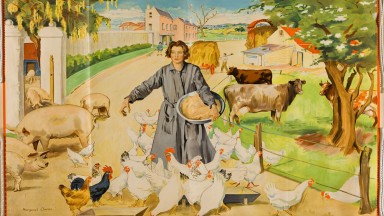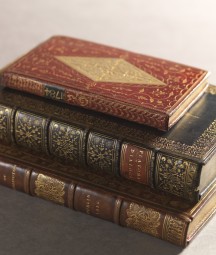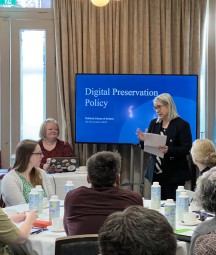Our Ephemera collection contains a poster produced by the Empire Marketing Board in 1930, designed by the Irish artist Margaret Clarke (1881–1961). The image depicts a young woman on a farm surrounded by hens, pigs and other farm animals.
When Margaret Clarke was undergoing research for her commissioned designs for the Empire Marketing Board her husband, the Irish stained glass and graphic artist Harry Clarke (1889–1931), wrote her a letter dated from 14th November 1929. In this letter, Harry advises Margaret to visit the National Library as part of her research for her designs. He wrote:
But meanwhile why don’t you go to the National Library—see Best (he is Dr. Best I believe) and he will do much for you—there they keep copies of all the important periodicals and those issued round the coal strike period would have pictures—as well they could have heaps of books on the subject for it is one of the most vital in Ireland... I hope that now you will be able to slog in on the posters—I wish I could help.
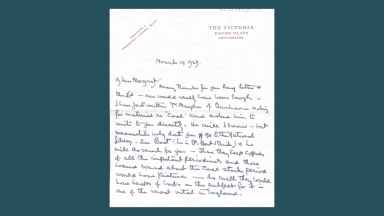
Harry Clarke's letter to his wife Margaret, 14 November 1929 (MS 48,419/2/6)
This letter shows an awareness from established figures in Dublin of the benefits and resources available at the National Library. That Harry references Dr. Best by name, as a figure within the Library who would be able to help Margaret with her research, further demonstrates his familiarity with the NLI.
Dr. Best refers to Richard Irvine Best (1872–1959) a former Director of the National Library. Best started his career at the Library in 1904—he rose to Chief Librarian in 1924 and then Director until he retired in 1940. He wrote heavily on Celtic philology and literature. While he did not attend university, Harry was right in correcting himself to include Dr., as Best received an honorary Doctor of Letters from the National University of Ireland (1920) and an honorary Doctor of Literature from Trinity College Dublin (1923).
For her commission, Margaret was looking for information on the coal industry for the fourth design in her five-part posters series. The NLI holds only the first three.
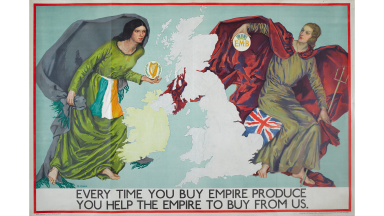
Every time you buy Empire produce you help the Empire to buy from us, poster (EMB/1)
The commission came from the Empire Marketing Board (EMB) – a department in the British government from 1926 to 1933. Britain wanted to withstand international competition from imported goods and establish an “Empire preference.” The EMB supported this goal by making publicity materials that promoted Empire goods and encouraged consumerism by the British populous.
The posters for Irish goods were an exception—in that, all other designs were produced by British designers, but the materials for Irish goods were done by Irish artists. This was the intervention of John Dulanty, the Irish Commissioner for Trade in London, who was very friendly with Irish writers and artists. Clarke was paid 275 pounds for her designs and won the Publicity Club of London’s prize for most popular poster in England in 1931.
Clarke’s posters themselves were also an exception to the rule. Typically, the posters contained rigid gender roles with men as the producers of good and women as the consumers. However, in Clarke’s initial scenes the “farm is subversively dominated by a farm woman.” While Clarke was keen to include her own objectives within the design, so was the Irish Free State. The posters would have the ability to not only increase mutual trade, but also portray Irish identity abroad.
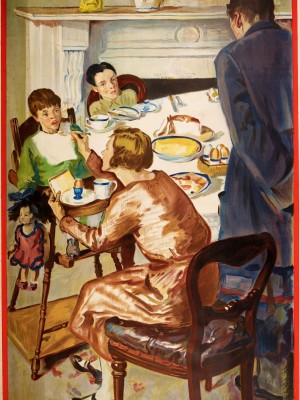
Irish Free State butter, eggs and bacon for our breakfast, poster (EMB/4)
Irish artist Paul Henry’s design for the EMB was ultimately rejected because the Free State thought it read as a tourism image, rather than highlighting agricultural efficiency. Though the current High Commissioner James MacNeill wanted to accept all efforts instead of “losing the value of an advertisement of this nature in the British press free of expense.” However, the EMB also wanted the Free State to accept the images. This is demonstrated in a letter sent to Margaret by John Dulanty on the 10th of January 1930. After discussing potential changes to areas of the design, and the particulars of payments and next steps, he writes:
I would like to make one final point and that is that we should try to carry the Department of Agriculture in Dublin on the poster. As I explained to you, it is the Empire Marketing Board who will pay for the work and whose opinion is therefore final but they are naturally anxious to say that their posters have the approval of the Dominion concerned.
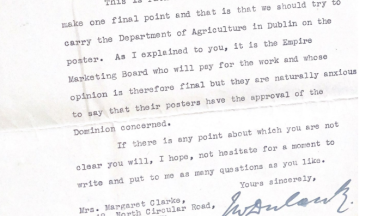
Letter from John Whelan Dulanty to Margaret Clarke, 10 January 1930 (MS 48,425/1/2)
Margaret Clarke’s pictures were highly praised—by the Empire Marketing Board, the Free State, and the public—and today the National Library holds those very designs she may have visited our Reading Room to research and complete.
-----
Sources
- Imagining Empire in the 1920s: Posters of the Empire Marketing Board – UK National Archives, Katherine Howell
- Selling Empire: The Empire Marketing Board – The Open University, Karl Hack
- The Empire Marketing Board, 1926-33: Britain’s failed attempt at soft trade policy – Centre for Economic Policy Research, Brian Varian, David Higgins
- Marketing the Free State in Britian – History Ireland, Billy Shortall
